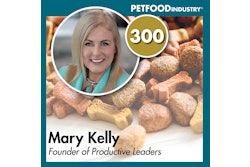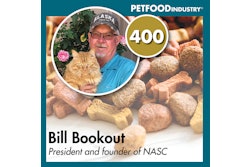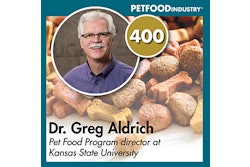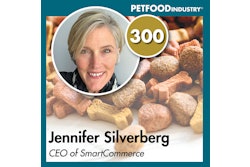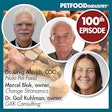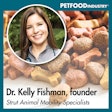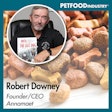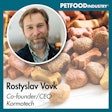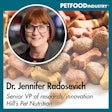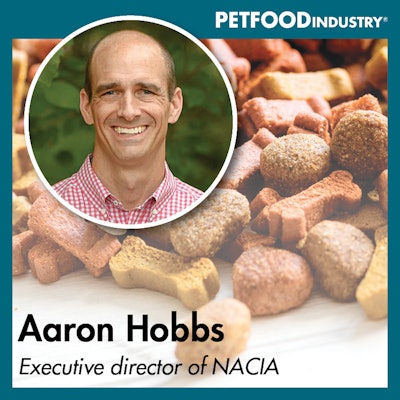
Insect protein as a pet food ingredient continues to grow in interest and discussion around the industry. I sat down with Aaron Hobbs, the executive director of the North American Coalition for Insect Agriculture (NACIA), to get a feel for where we're at and what NACIA is hoping to do for the pet food industry.
The below transcript is from Episode 30 of the Trending: Pet Food podcast, where I spoke with Executive Director of the North American Coalition for Insect Agriculture (NACIA) about the latest in insect protein as a pet food ingredient in North America. You can find the episode at www.PetfoodIndustry.com/trending-pet-food-podcast, on SoundCloud or on your favorite podcast platform. This episode originally aired on March 15, 2023.
(We want to thank AFB international for sponsoring this podcast. AFB is the premier supplier of palatants to pet food companies worldwide, offering off-the-shelf and custom solutions that make pet food, treats and supplements taste great.)
Lindsay Beaton – Editor, Petfood Industry magazine and Host, Trending: Pet Food podcast Hello, and welcome to Trending: Pet Food, the industry podcast where we cover all the latest hot topics and trends in pet food. I’m your host and editor of Petfood Industry magazine Lindsay Beaton, and I’m here today with Aaron Hobbs, executive director for the North American Coalition for Insect Agriculture. Hi, Aaron, and welcome!
Aaron Hobbs – Executive Director, NACIA
Hi, thanks for having me.
Beaton: In case you're not familiar with Aaron or NACIA, here's what you need to know. Aaron Hobbs is the first full time executive director of NACIA. Prior to joining the Coalition, Hobbs served in numerous capacities, including as President of RISE (Responsible Industry for a Sound Environment), a trade association based in Washington, D.C. He has previously served as director of the National Assembly of Sportsmen's Caucuses for the congressional Sportsmen's Foundation, international trade economist and presidential management fellow with the United States Department of Agriculture's Foreign Agriculture Service, and as a resource economist with USDA’s Natural Resource Conservation Service.
The mission of the North American Coalition for Insect Agriculture is to encourage positive use of farm insects in North America. NACIA is currently working to improve the regulatory environment in North America and connect its members with industry stakeholders and the knowledge they need to grow. The organization also works to inform key stakeholders about the potential for insects to provide environmentally sustainable, highly nutritious ingredients that can be produced as part of circular and regenerative agriculture.
Aaron’s position at the Coalition makes him the perfect person to dive into the continuing hot topic of insect protein and pet food, which is why I've brought him on today to answer this question: Where are we at with insect protein as an ingredient in 2023?
Now, Aaron, I want to start out by giving some background on NACIA in case people are not familiar with the organization, or haven't come across it yet in the pet food industry. How long has the Coalition been around, and what role does it play in the insect protein industry?
Hobbs: The organization has been gathering since I want to say 2016, and it has had many iterations since that time. The organization became official in 2019, when it was incorporated. And then I was invited to join the team in March of 2022. Our role in the industry and what we're doing has evolved as the organization has evolved, as we have grown up, and what we're doing today is a little different than what we were doing last year — and it's just the beginning of what we're going to do for the industry going forward. Our real focus right now is helping the industry mature and helping us become a fully viable and fully available protein source for pet food and other uses here in North America.
Beaton: Was insect protein something you had always had an interest in, or did you sort of fall into this role? How did your path lead you to insect protein?
Hobbs: How did I get here? That's a great one. So no, I have no background in insect protein, other than one of the great D.C. restaurants had cricket tacos on the menu and I've had them, right, as most people have. Really the reason I joined this team and how I got here is NACIA was looking for an executive director. And I saw the opportunity, I looked into it, and the things that attracted me to it were the innovation and the fact that this is a very innovative part of agriculture, the fact that they looked at themselves as a part of agriculture at large but again, a very innovative part of it. Frankly, I was attracted to the youngness of the organization, the opportunity to share the experiences and skills that I have, and really help them grow quickly and be successful. And then once I started to meet the people, the people are great, very passionate, very smart. And I thought, this is a team I'd love to be a part of. And here we are.
Beaton: It's definitely clear that insect protein has sort of exploded on the agricultural scene, and by extension the pet food scene, and it makes sense that a coalition has developed around this alternative protein that's getting more and more attention. What are some of the overarching insect trends you've learned about and seen in play since you joined NACIA last year, just in agriculture overall? And then let's start talking about in pet food specifically, as well.
Hobbs: Sure. Well, I've learned an enormous amount since I joined because again, I came in with practically zero knowledge specifically about insects. And so it's been really a wonderful experience to learn about the different insect uses globally. As NACIA we engage with global partners and so there's been a lot of learning opportunities there, about what is done with our peers and partners around the world, seeing the differences in the insects that are used, and how they're used and how they're brought to market or provided within the market in the individual countries, and then learning from that here in North America. In North America we're really focused on three insects: Black soldier fly larvae, mealworms and crickets. And so understanding the differences, understanding how the industry and the membership got to those insects as their primary focus has really been intriguing.
I would say that part of the industry today is pretty well set and established. And so really where I've spent most of my time is, again, applying my experiences, making sure that with particular focus on pet food how do we make sure that our ingredients are available for our customers to use in pet food manufacturing here in North America? And so a big focus for us has been understanding that regulatory framework. Fortunately, I have a bit of experience working with some of these regulators from past experiences. And so understanding where we are as an ingredient, how we get from where we are to where we need to be so that as the excitement continues to grow, as more and more people are looking to use our ingredients in their products, that we have them available, and the regulatory pathway, if you will, to that is clean and clear so that the road from where we are to where we want to be, all the speed bumps and potholes have been removed.
Beaton: Let's talk about the regulatory pathway a little bit. Because with these newer ingredients and alternative proteins coming out, obviously, there is some new ground to plow in terms of setting up the pathways and the regulations for these sorts of ingredients. So what challenges have you come across? And has there been anything that has surprised you about the way that things are going from a regulatory perspective in North America?
Hobbs: There have been no surprises, so I'll start at the end: There really have been no surprises; we are fortunate that the pathway is fairly clear. But having clarity on what the path is doesn't make it any shorter. And again, because of previous experience, I had an idea of what that path looked like and how long it might take to follow it. So 15 years ago, sure, I was surprised about how long things took. But I guess with my own personal maturity and experience, I'm not surprised by that.
Our biggest challenge has been, frankly, my newness to the organization and the organization as a group working together, and that the Coalition has been together for many years but some of the work that we're doing now requires a different level of engagement than people have been asked of in the past. And so we've had amazing success; I'm super excited about where we are in just 10 months, and a month from now or so we could get back together, Lindsay, and I would be able to lay out for you our path of how we get from where we are today to where we want to be, and what the timeline looks like and how we're going to focus what our individual priorities are going to be and how we're going to eat the elephant, if you will, to get all of our ingredients registered. So we have a great model with what's happened with black soldier fly larvae, and we're extrapolating from that how we provide the same regulatory certainty for all of the insects that we harvest here and we grow here in North America.
Beaton: It sounds like your membership is pretty willing to be active and very passionate about what they do, understandably. How has it been working with this particular segment of ingredients? It's still such a growing opportunity in terms of food and pet food ingredients and there's a lot of opportunity for them out there. So how has it been working with a group of people who are so passionate about something that still has so much ahead of it?
Hobbs: Awesome. It's been great. It really has been; it's just been a lot of fun. Every time there's a need for expertise, focus, time, so that we can move our industry forward, the members are readily willing to give it. You know, they're all extremely busy as everyone has these days. They're trying to grow their businesses, they're trying to have success within their own company. But everyone is excited; there is a real commitment to the future.
The theme that we've identified as NACIA for 2023 is a culture of collaboration. So really not only highlighting how collaborative the organization in the industry already is, but highlighting that and then expanding on it where we can understanding that a rising tide lifts all boats, we're all in this together. And there's just a lot of excitement. And it's not just from the current members of NACIA but also from the industry, so we've had a lot of excitement and some really intriguing conversations within the pet food industry. I happen to have a friend that works for one of the big companies and, you know, [she’s] super interested in what we're doing and quick to make connections with her team to further explore what those opportunities will be in the future. So it's just been a really fun time. Lots of energy, lots of excitement. You know, if you come to this industry one morning and you don't have the energy yourself somebody's going to give it to you just given all the excitement that currently exists.
Beaton: With all of that excitement in mind and with this trend moving so rapidly, it seems, in the last 10 months how have you seen the trends around insect protein kind of further cement themselves in consumer consciousness? And then how do you see the trends evolving in both the larger agricultural space and in the pet food space this year?
Hobbs: Big question there. As we continue our work, we continue to have success, we continue to see our ingredients in more and more places, insects used in more and more places, I expect over time — don't ask me a timeframe, I don't have one — but over time, a greater normalcy and acceptance of our ingredients. And I would say again, there is a lot of interest, there's a lot of excitement, there's a lot of willingness and desire, frankly, for the use of insect protein in a variety of use patterns, both with pets as well as other animals, and even in the human food space. And so I expect that that will continue.
Consumer acceptance has not been, very honestly, a primary area of focus of mine today. But I expect as the organization matures, and as we get some of our regulatory issues behind us, and we've again gotten that path very clear, we'll start to spend more time understanding that our members in particular have a much better understanding of what the consumer landscape looks like. And today, everything that they've said to me, everything that I hear in their conversations, the sky's the limit. So the desire is there, the demand is there, the interest and the willingness to use these ingredients are there. And so it's just providing the product is really where we're focused today.
Beaton: Things like sustainability, regenerative agriculture, eco-consciousness, these are all huge things that are helping to boost the interest in insect protein. What do you think are some of the top things that insect protein has going for it right now that are really good marketing points that can help sway people who still aren't quite there yet? Or will help continue to move along the regulatory conversation and get insect protein integrated into the larger ingredient portfolio for foods?
Hobbs: You're absolutely right, the sustainability profile and the environmental profile of insects is really exciting. And from a regulatory perspective, my perspective, my opinion on that is there is an understanding and an appreciation for the value that we provide from an environmental and sustainability standpoint. And you know, the regulatory process, it's not a matter so much of getting people to support the industry. It's just a process, and the process takes time. And so I think there is certainly excitement from our regulators; the ones that I've spoken with personally are excited to see this ingredient move through the regulatory process, they're excited to see the other insects get to where black soldier fly larvae is today. And they understand the value that we provide around environment and sustainability. So it's not really a point to convince them, I think they get it.
From my perspective, the customers that we have, they are also excited as well. And they are very interested in how they can utilize insect protein as an ingredient and take advantage of the environmental and sustainability benefits that they provide. And so we've been a part of numerous conversations with the entire food chain, as well as the pet food chain. Where I'm focused today is really understanding what those needs are, what are the questions that our customers are answering of their customers, and then how can we fit into that? How can we be part of the solution for them? And we're starting to build that portfolio or story, whatever word you want to use, to say, “Hey, if your customer is asking for this from an environmental profile, or if you're doing an environmental scoring and you need to meet these metrics, here's how we can be part of that solution for you.” And so we're working on all that, trying to pull that together and have that answer, if you will, to our customers so that [will] hopefully be a part of the answer that they have their ultimate customers.
Beaton: After being involved in insect protein for a little while now, what have you found is the most interesting thing about insect protein to you personally?
Hobbs: I love that the inputs for insects are something that is seen as a byproduct in some regards. I love that they can be fed things that aren't as valuable somewhere else, and what we get out of our insects is super high value. To me, it's just really cool that our insects, when they're ready to be eaten — whether it's by me or whether it's by the dogs and the cats or whether it's by you know, cows or whatever — it is a super dense, high-value product, and that's really cool. And then to go back — when I've had the opportunity to go to a farm where they're raising insects, and to see we're getting the super valuable, superpremium product on this end with a very different … it looks different. You know, I'm from East Texas, so I grew up around cows and ranching and farming. And to see that we have the opportunity to provide a really high-value product into the market to supplement our current food system with a very different environmental profile using very different inputs, inputs that others don't really see value in, that's just really awesome to me, right. We take something of medium to low value and the output of that is superpremium, super high value, really nutrient dense, and arguably as a protein powder, right, in just one form, from my non-scientific perspective doesn't really have a competitor as far as what it provides to people, pets or animals. That's what I find the coolest.
Beaton: I love that you say that, because that's one of the big things that really intrigues me about this whole insect protein thing as well, is that it's just so different from the other sources of animal protein we have. And they're farmed differently. And like you said, the inputs, the way they're fed, their various stages, the opportunities there, it's just really fascinating to finally be taking a look at this protein in a really concentrated, intentional way to see where it can fit in the larger perspective of things like sustainability, and the circular economy and regenerative agriculture, and all of the things that we're really starting to focus on as human beings and as people trying to make sure everything that needs feeding can continue to get fed as our respective populations grow. I like that you find that interesting as well. It's cool to hear that somebody else has honed in on that particular part of it all, and is just fascinated by the whole concept. Yeah,
Hobbs: Yeah, it's really fun.
Beaton: I want to give NACIA a little bit more airtime, because I want to give you a little bit more exposure to pet food in case there are people who haven't heard of it, people who might be looking into insect protein and would like an organization or a resource to go to. So what are NACIA’s plans for 2023, and how do you hope to further the cause of insect protein, specifically in the pet food space? How can you guys help the pet food arena when it comes to insect protein?
Hobbs: So in 2023 we will continue to, like I mentioned earlier, we will have a very clear path that we intend to follow to make sure that as soon as possible we have answered all the questions that might exist from a policy or regulatory standpoint. And so, you know, I would say by May 2023 we will be able to answer those questions, really, for anyone hopefully. My plan is anyone in the industry, in the pet food industry, that wants to know, “Hey, where are you? And how are you going to get to where you want to go?” we'll be able to answer that question as an industry. So I'm really excited about that.
Also, we are doing more this year around again, from the culture of collaboration around our theme, we're having more conversations this year than we did in my first 10 months with other parts of the industry. So if there are folks listening to this podcast that really want to get to know NACIA, that want to have a conversation with us, we’d love to hear from you. I've got three webinars already sketched in for the year where different parts of the industry are going to lead a conversation or lead a question-and-answer session with our membership, and building those to be beneficial to both, right, so where we learn from each other in a collaborative way. So if there are folks out there listening this podcast that are interested in that opportunity I’d love to talk to you.
We will be visible. I'm a big believer that the world is run by those who show up, so you should look for NACIA at your events this year; we won't make them all but I'll be at a lot of events, as many as we can afford to go to and we have the time to go to, but our members will be there as well. And you should look for, you know, the insect industry to be a visible and in-person player at pet food events there to answer your questions, talk about not only what they're doing, but I think frankly you'll find with most of our members that they're happy to tell you what their peers are doing and what's going on in the broader industry. So you're going to see us, look for us at your events but also come and find us. You can find us on our website, www.nacia.org. We have a LinkedIn page, I'm on LinkedIn as well. Happy to hear from, you happy to connect. Happy to talk further.
Beaton: Perfect. And thank you very much for speaking with me today, Aaron, because insect protein continues to be such a key topic in the area of alternative proteins in pet food and in other forms of food, so the more we stay on top of any developments the better. And I really wanted to get NACIA out there in front of the industry, because I think as this continues to grow we're going to need more resources and more knowledge, and the easier it is for people to get a hold of that the better.
Hobbs: Absolutely. Well, I really appreciate your interest, and your time and this opportunity, and I'm happy to connect as often as you feel it's appropriate. And to your listeners, thanks for giving us your ears for a few minutes.
Beaton: And That is it for this episode of Trending: Pet Food. You can find us on www.PetfoodIndustry.com, SoundCloud or your favorite podcast platform. You can also follow us on Instagram @trendingpetfoodpodcast. And if you want to chat or have any feedback, I'd love to hear from you. Feel free to drop me an email: [email protected]. And of course, thanks again to our sponsor AFB International, the premier supplier of palatants to pet food companies worldwide offering off-the-shelf and custom solutions that make pet food, treats and supplements taste great. Once again, I'm Lindsay Beaton, your host and Editor of Petfood Industry magazine, and we'll talk to you next time. Thanks for tuning in!


